Poinsettia Phytoplasmas
Poinsettias are a tropical plant native to Central and South America. In 1825 they were first introduced to the USA and used as a holiday cut flower. Improved varieties introduced in the mid 1900’s were a new type of poinsettia sold as a potted plant: one that was dwarfed compared to the wild type and was naturally very branchy making a very attractive and floriferous plant. It was not until 1995 that Poinsettia branch inducing phytoplasma was identified as a microbe causing these symptoms. Although many plant diseases have a bad reputation, Poinsettia branch inducing phytoplasmas are a highly desired plant pathogen for poinsettia breeders and buyers.
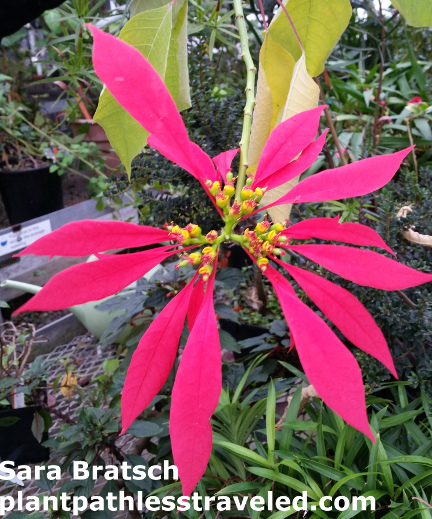 Wild type Euphorbia pulcherrima (poinsettia) flower.
Wild type Euphorbia pulcherrima (poinsettia) flower.
Introduction
Poinsettias, also known by their scientific name of Euphorbia pulcherrima Wild, are native to tropical Mexico, Belize, Guatemala, El Salvador, Honduras, Nicaragua, and Costa Rica. They were grown for their flowers which bloomed during December-January, dyes, and latex. It was not until 1825 that poinsettias were introduced to the USA by Joel Poinsette, who the common name of poinsettia (used in the USA) is derived from. Poinsettias were originally sold mainly as cut flowers due to the fact that the plants grew quite large and had limited branching (10, 12).
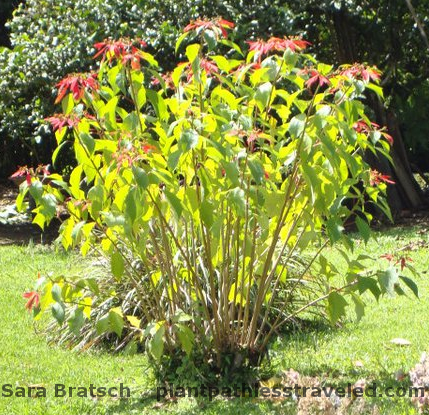 A ~6 foot tall poinsettia in Costa Rica blooming on one year’s growth. Note the lack of branching and thin leaves at the top (the "flowers") compared to modern varieties.
A ~6 foot tall poinsettia in Costa Rica blooming on one year’s growth. Note the lack of branching and thin leaves at the top (the "flowers") compared to modern varieties.
Variety development
Horticulturalists rapidly developed new varieties of poinsettias and today they are grouped into two types. One type is used for flowers and resembles the wild variety that has limited branching and can grow into a shrub. The cut flower poinsettia was the most common variety grown before the 1960’s (6).
The most commonly sold type today is used as a potted plant and is dwarfed in size and nicely branched to provide a very floriferous and attractive plant. The first report of a shorter poinsettia was in 1923 from the USA. In 1945 another greatly improved poinsettia was introduced again from the USA that had even better branching and flowering. In 1967 a superior variety was introduced from Norway which had an even greater amount of branching than observed in previous cultivars and retained its leaves much longer than previous varieties (15).
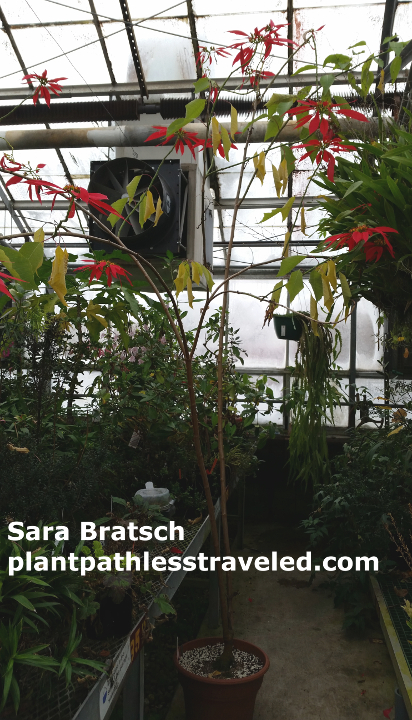 Greenhouse grown wild type Euphorbia pulcherrima plant stretching to over 10 feet tall in the greenhouse.
Greenhouse grown wild type Euphorbia pulcherrima plant stretching to over 10 feet tall in the greenhouse.
Early observations
Plant breeders would routinely treat their new poinsettia varieties with heat or tissue culture techniques to eliminate any viruses that had been introduced during the breeding process (8). However, they noted something critical to their new varieties would be eliminated after this virus cleaning process: the increased branching and dwarfing observed in the plant before treatment was eliminated and did not return. In 1983 a paper describing the ability to restore the branching habit by grafting a clean poinsettia after virus treatment onto a branching poinsettia for a rootstock was published (14).
Other early studies into what was causing the dwarfing and increased branching of some poinsettias suggested that Poinsettia mosaic virus or poinsettia cryptic virus were causing the symptoms, however the viruses could also be found in the taller wild varieties (7, 8, 9, 4, 5).
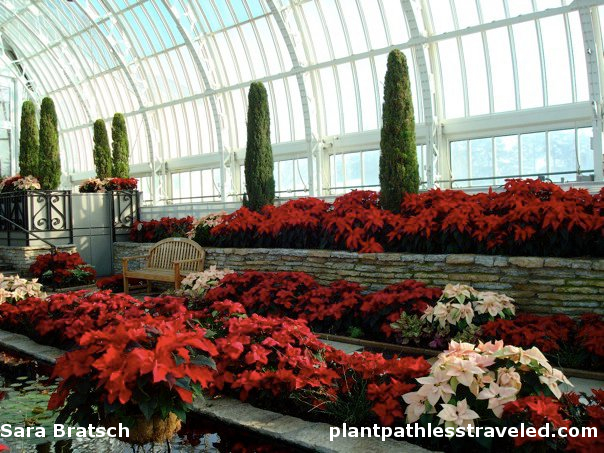 Potted poinsettias used for holiday decoration. Note the small stature and branching making a very floriferous plant compared to the wild type.
Potted poinsettias used for holiday decoration. Note the small stature and branching making a very floriferous plant compared to the wild type.
Identification of symptom causing microbe
No other microbe was observed until 1995 when a group of scientists working with the commercial horticulture industry sequenced pieces of DNA from a new phytoplasma they called Poinsettia branch inducing phytoplasma (PoiBI) (11). This group also showed it was possible to transmit the phytoplasma to a healthy (non-branchy) poinsettia and it would induce the plant to begin branching (10, 11).
Phytoplasmas are a group of microbes that are similar to bacteria. Unlike bacteria, phytoplasmas do not have a cell wall and cannot be cultured in media. Phytoplasmas require a living plant host to survive and can be transmitted by grafting, a parasitic plant called dodder, or their specific insect vector (leafhoppers, planthoppers, and psyllids) (2). Similar to bacteria, phytoplasmas can be killed with antibiotics and when branching poinsettias were treated with antibiotics this caused the plants to lose their free-branching habit (3).
Further molecular based research has shown that all branching and dwarfed poinsettias have at least one type of phytoplasma present in them, with some species of phytoplasma that are not closely related to the PoiBI species (1, 10, 13). At this time it is unknown how the novel free branching poinsettia varieties were infected by these phytoplasmas. Many plant breeders also utilized mutation breeding (chemical or radiation) to produce new poinsettia varieties which would also cause mutations in the phytoplasma(s) present (12). This makes it difficult to identify the specific population of phytoplasmas that cause the attractive branching of potted poinsettias today, and it is likely that there are several different groups of phytoplasmas that can cause dwarfing and branching in poinsettias (12).
Although many plant diseases have a bad reputation, Poinsettia branch inducing phytoplasmas are a highly desired plant pathogen for poinsettia breeders and buyers.
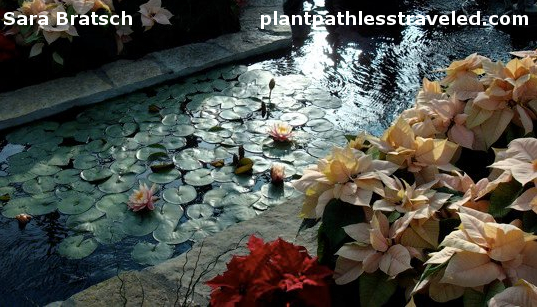 Potted poinsettias used for holiday decoration. Note the small stature and branching making a very floriferous plant compared to the wild type.
Potted poinsettias used for holiday decoration. Note the small stature and branching making a very floriferous plant compared to the wild type.
All photos taken by Sara Bratsch. For non commercial use only.
Please contact regarding all other uses including but not limited to: data for computational algorithms, books, pamphlets, articles, apps, websites, etc.
Cite this article:
Bratsch, Sara. 2017. "Poinsettia Phytoplasmas". Web article. (date accessed). https://www.plantpathlesstraveled.com/poinsettia-phytoplasmas/
Citations
- Abad, I., Randal, J.A. and Moyer, J.W. 1997. Genomic diversity and molecular characterization of poinsettia phytoplasmas. Phytopathology 87:S1.
- Bertaccini, A., & Duduk, B. 2010. Phytoplasma and phytoplasma diseases: a review of recent research. Phytopathologia mediterranea, 48(3), 355-378.
- Bradel, B.G., Preil, W., and Jeske, H. (2000). Remission of the free-branching pattern of Euphorbia pulcherrima by tetracycline treatment. Journal Of Phytopathology 148, 587-590.
- Dole, J. M., Wilkins, H. F., and Desborough, S. L. 1993. Investigation on the nature of a graft-transmissible agent in poinsettia. Can. J. Bot. 71:1097-1101.
- Dole, J. M., Wilkins, H. F. 1994. Graft-transmissible branching agent. The scientific basis of poinsettia production. Strømme E., ed. The Agricultural University of Norway. 121: 45-48.
- Ecke Jr., P., Matkin, O. A., and Hartley, D. E. 1990. The Poinsettia Manual, 3rd ed. Paul Ecke Poinsettias, Encinitas, CA.
- Fulton, R.W. and Fulton, J.L. 1980. Characterization of a tymo-like virus in poinsettia. Phytopathology 70:321-324.
- Koenig, R. and Lesemann, D.E. 1980. Two isometric viruses in poinsettia. Plant Disease 64:782-784.
- Koenig, R., Lesemann, D. E., and Fulton, R. W. 1986. Poinsettia mosaic virus. AAB Descriptions of Plant Viruses, No. 311.
- Lee, I.-M., Tiffany, M., Gundersen, D. E., and Klopmeyer, M. 1995. Phytoplasma infection: A beneficial factor for production of commercial branching poinsettia cultivars? Phytopathology 85:1179.
- Lee, I.-M., Klopmeyer, M., Bartoszyk, I. M., Gundersen-Rindal, D. E., Chou, T.-S., Thomson, K. L. and Eisenreich, R. 1997. Phytoplasma induced free-branching in commercial poinsettia cultivars. Nature Biotechnology 15:178-182.
- Nicolaisen, M. 2001. phytoplasma with the focus on Euphorbia pulcherrima and other ornamental plants’.
- Pondrelli, M., Caprara, L., Bellardi, M. G., & Bertaccini, A. (2000, May). Role of different phytoplasmas in inducing Poinsettia Branching. In X International Symposium on Virus Diseases of Ornamental Plants 568 (pp. 169-176).
- Stimart, D. P. 1983. Promotion and inhibition of branching in poinsettia in grafts between self-branching and non-branching cultivars. J. Amer. Soc. Hort. Sci. 108:419-422.
- Strømme, E. 1994. The Scientific basis of poinsettia production. The Agricultural University of Norway, Aas-NLH, Norway.